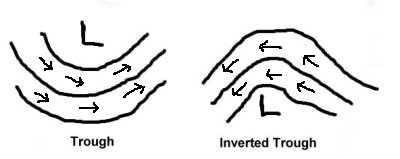
| WHAT IS AN INVERTED TROUGH?
| |||||||||||||||||||||||||||||||||||||||||||||||||||||||||||||||||||||||||||||||||||||||||||||||||||||||||||||||||||||||||||||||||||||||||||||||||||||||||||||||||||||||||||||||||||||||||||||||||||||||||||||||||||||||||||||||||||||||||||||||||||||||||||||||||||||||||||||||||||||||||||||||||||||||||||||||||||||||||||||||||||||||||||||||||||||||||||||||||||||||||||||||||||||||||||||||||||||||||||||||||||||||||||||||||||||||||||||||||||||||||||||||||||||||||||||||||||||||||||||||||||||||||||||||||||||||||||||||||||||||||||||||||||||||||||||||||||||||||||||||||||||||||||||||||||||||||||||||||||||||||||||||||||||||||||||||||||||||||||||||||||||||||
METEOROLOGIST JEFF HABY
In the mid-latitudes of the Northern Hemisphere a
trough is usually seen as a southerly bulge in the
height contours.
The lowest heights are generally located to the north of the trough. In an inverted trough situation, the
height contours bulge to the north. This is more common in the tropical regions where regions of low pressure
ride south of a mid-latitude high pressure but can happen in the mid-latitudes when low pressure is south of
high pressure. An inverted trough bulges to the north. At first it may look like a ridge, but on further
inspection it is a trough. Both a trough and an inverted trough have a cyclonic (counterclockwise) flow
pattern. A trough will tend to have more westerly winds associated with it while an inverted trough will
tend to have more easterly winds associated with it. If an inverted trough is actually a ridge then the winds
will be flowing with the height contours in the opposite direction (anti-cyclonic direction). The direction
of windflow through the feature is how a ridge is discerned from an inverted trough.
Tropical waves will show up as inverted troughs because they are
generally south of mid-latitude high
pressure and have an easterly wind associated with them. Below are an example of a trough
and an inverted trough.

|
|
|

